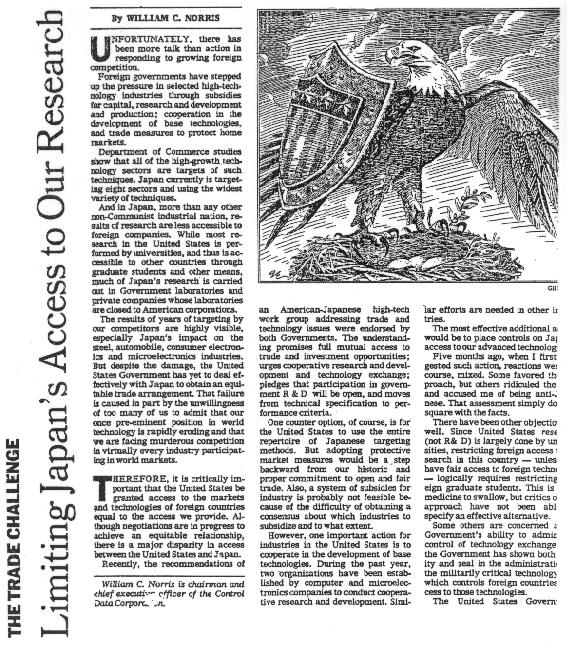

SECOND DRAFT
Proposed Book
"Electronic Global University System and Services"
To be published by
Idea-Group Publishing Company
Harrisburg, PA
(In negotiation)
July 28, 1998
Takeshi Utsumi, Ph.D.
Laureate of Lord Perry Award for Excellence in Distance Education
Founder, Consortium for Affordable and Accessible Distance Education (CAADE)
President, Global University in the U.S.A. (GU/USA)
A Divisional Activity of GLOSAS/USA
(GLObal Systems Analysis and Simulation Association in the U.S.A.)
43-23 Colden Street, Flushing, NY 11355-3998, U.S.A.
Tel: 718-939-0928; Fax: 718-939-0656 (day time only--prefer email)
Mailto: utsumi@columbia.edu
(Note: Some of hypertexted diagrams and news clippings
are not in high resolution, since they are scanned images.
Those images with green border
are not linked.
One page image is for presentation and double page one is for reading.
Please feel free to send me your
comments. Thanks.)
Part 1
GLOSAS ACTIVITIES
Chapter 1
PERSONAL RECOLLECTIONS
ON THE INCEPTIONS OF
PEACE GAMING AND GLOBAL UNIVERSITY SYSTEM
1 Computer Simulation and Gaming 1.1 Calculators 1.2 Digital computer 1.3 Slow-time analog computer 1.4 Repetitive analog computer 1.5 Continuous system simulation languages 1.6 Global time-sharing services 1.7 Hybrid computer 1.8 Dumb terminal with monitor 1.9 All-in-one approach 1.10 Summer Computer Simulation Conference 1.11 War and peace gamings 1.12 E-mail through global time-sharing service network 1.13 Idea of globally distributed computer simulation system 2 Packet-switching data communication network 2.1 Failed effort to extend ARPANET to Japan 2.2 Inception of global peace gaming 2.3 E-mail as message exchange via computer 2.4 U.S.-Japan Energy, Resources and Environment (ERE) peace gaming 2.5 Wireless data telecommunications 3 Extension of U.S. packet-switching data telecommunication to Japan 3.1 Inauguration of commercial packet-switching service in the U.S. 3.2 Effort of extending U.S. VANs to overseas 3.3 Battle to inaugurate KDD's ICAS data telecommunication service 3.4 Prohibition of the use of e-mail 3.5 De-regulation of the Japanese telecommunications policy for the use of e-mail through the U.S. government 3.6 Extension of NSF's CSNET to Japan 3.7 Electronic Information Exchange System (EIES) 3.8 Distance learning with EIES 3.9 Marketing of U.S. software 3.10 Marketing of HEP 3.11 De-regulation for the use of receive-only antenna 3.12 Remarks REFERENCES INSERTIONS (Images, graphs and diagrams, etc.)
PERSONAL RECOLLECTIONS
ON THE INCEPTIONS OF
PEACE GAMING AND GLOBAL UNIVERSITY SYSTEM
3 Extension of U.S. packet-switching data telecommunication to
Japan
3.1
Inauguration of commercial packet-switching service in the U.S.
Telenet (which became GTE/Telenet and now Sprint) was established in
1976 by BBN with Larry Roberts (former BBN man and then Director of ARPANET)
as its president, in order to commercially provide packet-switching data
telecommunication services -- the so-called unregulated "enhanced services"
or value added network (VAN). I immediately visited them in Washington,
D.C. and started helping their overseas expansion and use of e-mail (then,
Telemail, and later SprintMail). They confronted with a decision on either
their overseas extension should be conducted by themselves or to rely on
the already existing telex service providers, e.g., ITT World Communications,
Western Union International (WUI) or RCA Global Communications (Globcom).
I commended them to take the latter [42].
[Go to CONTENTS]
3.2 Effort
of extending U.S. VANs to overseas
Because of anticipated resistance by the Japanese telecommunication industries
(e.g., the Ministry of Posts and Telecommunications (MPT), KDD and NTT),
I promoted the awareness of Japanese on the new packet-switching technology
with many publications in professional journals which resulted articles
in major newspapers appealing to retrieve "treasures" of abundant
information from the U.S. [43] (Nikkei Shimbun, November 27, 1978) (Asahi Shimbun, March 12, 1979) (Nikkei Sangyo Shimbun, March 22, 1979). I also helped
American telex service providers to extend Telenet's service through their
networks to Philippines, Hong Kong, Singapore, Australia, New Zealand, Taiwan,
etc. [44].
During this process, I visited the governor of Guam Island, since Guam is the hub of underseas telecommunications cables around the Pacific rim countries. I also visited British Telecom and Cable & Wireless (C&W) in London, since C&W controlled the telecommunications of Hong Kong. I thought that if Hong Kong would get Telenet, KDD would have to follow the suit since C&W in Hong Kong was a keen rival to KDD. In February of 1978, I attended the First Transnational Data Regulation Conference organized by European Parliament and held in Brussels, Belgium. I appealed the delegates from European telecommunication industries and governments for globalization of VANs. However, I was shocked to find the articles in a major British computer industry journal to oppose my appeal (Computing Europe, February 16, 1978), especially in such a country as Britain where global governance of colonial commonwealth was once prominent -- another example of how difficult it is to change "mind" for new technology.
After Taiwan got the extension of Telenet, KDD finally decided to have
it also. In response to the KDD's decision, American telex service providers
submitted the U.S. Federal Communications Commission (FCC) their applications
to extend their services to Japan.
[Go to CONTENTS]
3.3 Battle to inaugurate KDD's ICAS data telecommunication service
The American telex service providers' applications met with counter-petitions from GEISCO and CDC to block their extensions to Japan until Japan de-regulated their telecommunications policies. This was because GEISCO had serious difficulty to extend their services to Japan compared with the case when they extended their services to Hong Kong with Cable and Wireless of London. CDC's contention was this (Norris, William C., "Limiting Japan's Access to Our Research," The New York Times, July 24, 1983); Previously, IBM sold their time-sharing service in Cleveland, Ohio, to CDC due to their consent with the Justice Department, which service was then extended to Japan. CDC tried to provide their Cyber service in Minneapolis, Minnesota to Japan, also. Instead of having a direct leased line from Minneapolis to Tokyo, they wanted to connect their mainframe computer in Minneapolis with the time-sharing service computer in Cleveland, and use its leased line from Cleveland to Tokyo. This meant that the computer in Cleveland had to route data from Minneapolis without changing its content. This was an infringement of the Japanese telecommunication policy, though such routing was to be done outside the jurisdiction of Japan. I submitted a thick petition with many letters of support to the FCC for countering with GEISCO and CDC, with contention that Japanese were not totally ignorant, and if it was allowed, they would realize by themselves how their regulations were so ridiculous [44a]. A famous law firm in Washington, D.C. said on behalf of CDC (billions dollar revenue firm) that my favor to the American telex service providers was "patently unfair." The FCC finally announced their decision saying that they duly considered my contention for their decision [45] (Nikkei Shimbun, December 15, 1979).
In spite of the FCC's decision, KDD took several months to adjust with their VENUS operation to inaugurate their International Computer Access Service (ICAS) (Asahi Shimbun, July 16, 1980) in September of 1980 (Nikkei Shimbun, July 31, 1980), until they learned that Bundespost (Germany's monopolistic telecommunication company) airshipped a router from the U.S. ICAS was an instantaneous success drawing many crowds to its demo (Nikkei Shimbun, September 5, 1980) with ten times more than expected users (Nikkei Shimbun, September 12, 1980) (Nikkei Shimbun, December 22, 1980).
[Go to CONTENTS]
3.4 Prohibition of the
use of e-mail
However, when I read the user manual of ICAS, I found a fine print saying that the exchange of a message by a computer without changing its contents (e.g., e-mail, etc.) was prohibited. KDD was also cunning enough to have deliberately used the word "processing" instead of "changing" in its English version for overseas users, as if it would have complied with ITU's CCITT recommendations.
According to this regulation, a Japanese user had to use bulky and expensive
telex to send his request for a full paper after searching a desired paper
by abstracts in a databank, to the information service providers in the
U.S. KDD affirmed this when I inquired about it. This was obviously against
my original intention of extending the U.S. data telecommunications network
to Japan, for using e-mail for collaborative communications among peace
gaming players and for questions and answers (Q&A) between instructors
and students and among students of my planned Global University System [46].
[Go to CONTENTS]
3.5
De-regulation of the Japanese telecommunications policy for the use of e-mail
through the U.S. government
After investigating the situations with the Japanese Ministry of Post and Telecommunications, Diet members, NTT, KDD, and information service providers in Japan in the spring of 1981, I reported it at a meeting at the U.S. Commerce Department, which gathered staffs from the White House, State Department, USTR, USTFC, FCC, NTIA, USIA, etc. I urged them to pressure the Japanese government for the de-regulations of their telecommunications policies, particularly for the use of e-mail and computer conferencing system. I also warned them that severe U.S.-Japan trade conflicts would rise soon after the divesture of AT&T. In order to secure my appeal to them, I submitted a thick petition with many letters of support to the Commerce Department in August of 1981.
When Late Commerce Secretary Malcom Baldrige visited Japan in October of 1981, he requested the de-regulation of the Japanese telecommunications policy for the use of e-mail and computer conferencing through U.S.-Japan public packet-switching lines, as one of three non tariff barriers (Chunichi Shimbun, October 31, 1981) -- this was the first of many subsequent U.S.-Japan trade issues on the non-tariff barriers. The Japanese Ministry of Posts and Telecommunications and KDD finally complied with my request and started allowing the use of e-mail from April 1, 1982 (U.S. Dept. of Commerce, 1982, Letter of Notification) [47].
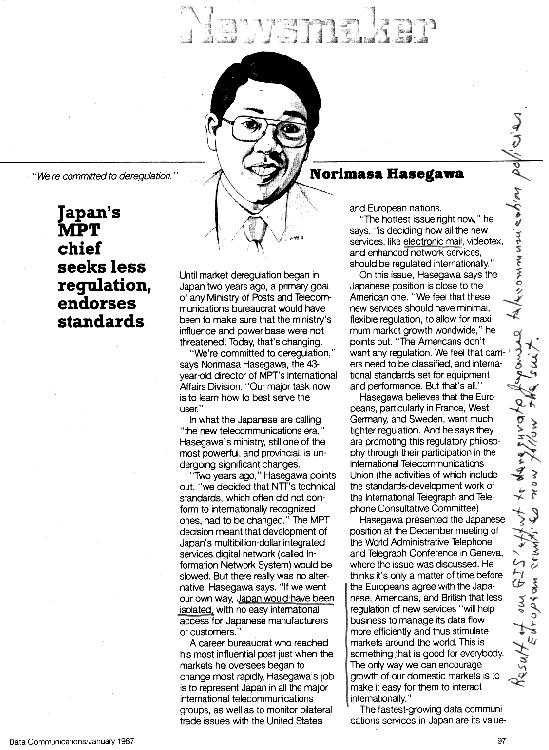 Around
this time, KDD inaugurated their VENUS data telecommunications service.
I requested a U.S. Commerce Department officer to obtain its user manual
for me, since I could not trust their operation from my previous experiences.
I found the prohibition of e-mail with VENUS in the user manual, even though
its use was approved via ICAS by the economic ministers' committee. I had
then again to spend several more months for its de-regulation through another
agency of the Japanese government. Even after this de-regulation, it was
only for Japanese using American e-mail services but not the other way around.
Around
this time, KDD inaugurated their VENUS data telecommunications service.
I requested a U.S. Commerce Department officer to obtain its user manual
for me, since I could not trust their operation from my previous experiences.
I found the prohibition of e-mail with VENUS in the user manual, even though
its use was approved via ICAS by the economic ministers' committee. I had
then again to spend several more months for its de-regulation through another
agency of the Japanese government. Even after this de-regulation, it was
only for Japanese using American e-mail services but not the other way around.
In April of 1984, the Japanese Ministry of Posts and Telecommunications made a major revamping of telecommunications policies. I sent again many thick petitions to the U.S. and the Japanese governmental agencies, AT&T, IBM, Hughes Aircraft, Honeywell, Telenet/Tymnet, CSC, CDC, Lockheed, SDC and many other major industries, and President Reagan, Commerce Secretary Baldrige, etc. I urged the U.S. Trade Representatives (USTR) to pressure the Japanese government [48]. Almost all of my requests on the complete liberalization of data telecommunications and penetration of American service companies to Japan [49] were conveyed by the USTR and American Ambassador to the Japanese government and finally approved.
The above efforts helped achieve a de-monopolization and liberalization
of the Japanese telecommunication industries, thus enabling various private
terrestrial and satellite communication service companies to emerge. This
easing of restrictions included a statutory provision allowing the entry
of foreign enterprises (particularly IBM's network) into the Japanese telecommunication
markets. This enabled cost reductions of telecommunications -- down to one
fifth to one eighth of the previous cost in only one decade. The European
Economic Community (EEC), Latin American countries and others have followed
the suit (now 80 countries with Internet access and 180 with e-mail access).
Japanese initiatives were a model for the world (Berger, Michael, 1987, "Newsmaker: Japan's MPT chief
seeks less regulation, endorses standards," Data Communication, January,
Page 97 to 98) [50]. The way has been paved for the global educational
exchange with experiential learning via various telecommunication media
in the service of better understanding of global issues.
[Go to CONTENTS]
3.6 Extension of NSF's
CSNET to Japan
 Computer
Science Research Network (CSNET) of the U.S. National Science Foundation
(a predecessor to Internet) was a general purpose communication network
capable of linking all computer science research groups in universities,
industry and government in the United States. CSNET was a logical network
spanning several physical computer communication networks, including ARPANET,
public packet networks (e.g., TELENET and TYMNET), and PHONENET (a telephone
based message relay system). PHONENET used telephone links to incorporate
hosts not residing on any network into CSNET. As new public networks were
established, CSNET expanded to accommodate hosts connected to them.
Computer
Science Research Network (CSNET) of the U.S. National Science Foundation
(a predecessor to Internet) was a general purpose communication network
capable of linking all computer science research groups in universities,
industry and government in the United States. CSNET was a logical network
spanning several physical computer communication networks, including ARPANET,
public packet networks (e.g., TELENET and TYMNET), and PHONENET (a telephone
based message relay system). PHONENET used telephone links to incorporate
hosts not residing on any network into CSNET. As new public networks were
established, CSNET expanded to accommodate hosts connected to them.
Gateways connected the component networks (Diagram of CSNET). Adoption of a common addressing method and a uniform protocol architecture enabled communication between any two CSNET hosts. As the project developed, interprocess communication protocols and additional capabilities were added. CSNET evolved by adopting new technologies as it became available; it continued to offer state-of-the-art computer communications services to the computer science research community.
CSNET used existing facilities where they were available. Some sites had ARPANET connections. Other sites gained access through public packet network connections. Sites that could not justify connection into a public packet network gained access to CSNET via PHONENET. Individual researchers who could not gain access by any of these methods could still use CSNET via a so-called Public Host. Every computer science researcher therefore had some access route to this complex.
Communication services provided initially included message services, file transfer, and access to remote database and system resources. Message service permitted rapid exchange of messages or documents from one researcher to another. The impediments to communication posed by differing work schedules, time zones, delivery delays, and the higher cost of long distance telephone were thereby avoided. File transfer permitted software packages or data to be shipped along with the network from one computer to another. For instance, design files for fabrication of integrated circuits could be transported in this way. Remote database access involved the reading and writing of data in files of other researchers at remote locations. Thus, a variety of databases could be maintained over the network such as software directories and technical papers. The availability of these services amplified the effectiveness of communication among computer scientists.
In 1981, I made an initial effort of extending this CSNET to Japan as contacting echelons of Japanese government and Liberal Democratic Party (Extension of CSNET to Japan). This project was later undertaken by Professor Haruhisa Ishida of the University of Tokyo (Ishida, H., 1991). Professor Ishida is now the Chairman of the Internet Association of Japan.
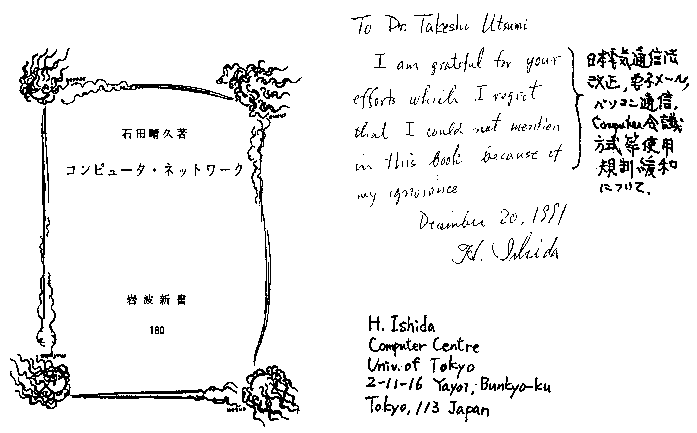
The most satisfying and delightful words I received during my visit to Japan in April of 1998 was an acknowledgement given from Dr. Hiroshi Inose, Director General of the National Center for Science Information System (NACSIS) of the Japanese Ministry of Education, who said to me; "Thank you, Dr. Utsumi, for your effort which brought Internet into Japan." The NACSIS is the center of the inter-university Internet in Japan which administers the broadband backbone network and a gateway to overseas countries. Dr. Inose is the Laureate of the Medal of Culture (the "Bunka Kunsho" in Japanese), the highest honor in Japan.
On the other hand, however, I was very dismayed to find out that the
use of Internet in Japan was greatly behind to the U.S. -- more than 10
years, according to Professor Shumpei Kumon, Director of Global Communication
Center of the International University in Tokyo (FORBES, June, 1998, Japanese
version). This is in comparison to the enthusiastic support of the U.S.
Congress and the White House administration to proliferate the Internet
to every elementary and secondary schools in the U.S. This Japanese lag
may be due to (a) scarce competition among Internet service providers, (b)
tradition and culture of education system, (c) feudalistic, vertical hierarchy
of society, (d) political governance of K-12 education separating from higher
education system, etc.
[Go to CONTENTS]
3.7 Electronic
Information Exchange System (EIES)
At the International Conference on Computer Communications (ICCC) held in
Washington, D.C. in October, 1972 (which was mentioned above), I saw a demonstration
of EMISARI computer conferencing system. This was used at the Executive
Office of the President for Wage and Price Control program under Nixon administration.
I thought this would be the most suitable coordination media among peace
gaming players.
The successor of EMISARI was the Electronic Information Exchange System (EIES) of the New Jersey Institute of Technology [51]. After the de-regulation of e-mail in Japan, I started marketing it to many secondary schools in Japan. However, it was a difficult task because Japanese were usually shy to express themselves in addition to their language problem with English.
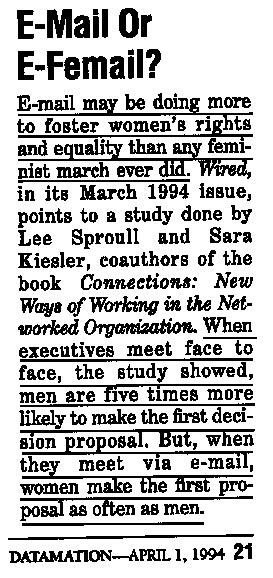 Although this was only text-oriented message
exchange system, it was used for several pioneering distance education programs
with students from around the world. One of the interesting results was
that, if distance education was used, oriental students often submitted
twice much materials than American students, though orientals were usually
shy and not to raise questions at the face-to-face classrooms. Same is said
about female (Datamation, April 1, 1994, "E-Mail Or E-Female?").
Although this was only text-oriented message
exchange system, it was used for several pioneering distance education programs
with students from around the world. One of the interesting results was
that, if distance education was used, oriental students often submitted
twice much materials than American students, though orientals were usually
shy and not to raise questions at the face-to-face classrooms. Same is said
about female (Datamation, April 1, 1994, "E-Mail Or E-Female?").
Equivalently excellent computer conferencing system around that time was
NOTEPAD made by Jack Vallee, which was used by many industrial firms, non-profit
organizations, and even by NASA. When it was proliferated among NASA employees,
its echelons were bewildered with many messages they received everyday so
that they had to stop the use of e-mail. Right after this, Challenger disaster
occurred, since the message warning the deficiency of O-ring in cold weather
from an engineer of Thiokol could not reach to the top of NASA just a few
days prior to the disaster [52]. The engineer was happened to be my junior graduate
from the Chemical Engineering Department of Montana State University in
Bozeman, Montana -- he received a medal from the university later.
[Go to CONTENTS]
3.8 Distance learning with
EIES
In January of 1985, I had an opportunity to receive a scholarship to take
the first distance learning seminar with the use of EIES for six months,
which was organized by Western Behavioral Science Institute in La Jolla,
California. The lecturers were prominent scholars, such as Walter Roberts,
founder of the National Center for Atmospheric Research (NCAR) in Boulder,
Colorado, and the former president of American Association for the Advancement
of Science, etc. Students were from industries and governmental agencies.
Prior to the distance learning seminar, they conducted a face-to-face workshop
and conference where lecturers presented the outlines of their planned courses
and students could learn how to log on the EIES with their personal computer
and a modem at their office or home. Albeit only text-oriented messages,
discussions through EIES were very intensive and interesting -- for two
months for each lecturer. However, our discussions were sparse during the
session of the lecturer who missed the face-to-face meeting in La Jolla.
This experience taught me how important and effective the face-to-face
meeting prior to the distance learning seminar is. In other words, if we
can have a good human contact with a face to-face meeting, we need not always
have video of instructors during distance learning -- more later.
[Go to CONTENTS]
3.9 Marketing of U.S. software
The USTR also pressured Nippon Telegraph and Telecommunications (NTT)
for their liberalization of procurement policy to buy American equipment
and computer software. Dr. Saburo Okita (former chief of Japan Club of Rome)
visited Washington, D.C. to sign the agreement. I then helped marketing
a software engineering system to the central laboratory of NTT which was
equivalent to Bell Lab of AT&T in New Jersey. This system was based
on a mathematical model of Rayleigh equation (which has a skewed probability
curve), and to be used for planning of a software development project for
cost saving and improving its programming quality. This was one of the three
items NTT firstly purchased from overseas countries [53]. For its customer service, we extensively used
EIES.
[Go to CONTENTS]
3.10 Marketing of HEP
In early 1970s, there was an international conference on computer simulation
in Tokyo. I met David Miller of Denelcor (mentioned above) there and discussed
the possibility of massively parallel digital processor as replacing amplifiers
of analog computer with digital processors. He later developed Heterogeneous
Element Processor (HEP) with Max Gilliland, who developed the hybrid computer
at Beckman Instrument (mentioned above), for the U.S. Army Ballistic Research
Laboratories. This was the first commercially available parallel digital
computer with 50 digital processors with "Multiple Instruction Multiple
Data (MIMD)" stream structure to achieve 500 million instructions per
second [54]. I helped him to market it in Japan, but in vain
-- due to the difficulty of its programming, compared with some successful
installations in the U.K., Germany and other European countries [55].
[Go to CONTENTS]
3.11
De-regulation for the use of receive-only antenna
In 1990, I also made an effort to de-regulate the Japanese telecommunication
policies for the use of receive-only antenna to receive signals directly
from INTELSAT satellites for educational and non-profit purposes.
Extending communications through a global network and sharing ideas and educational opportunities with other locations is of a paramount interest. The quality of education for those unable to attend conventional universities in disadvantaged countries could be greatly enhanced. Such distance educational service can also become an exportable commodity to remedy American trade deficits.
The INTELSAT system was originally established for satellite telecommunications. Because of its monopolistic structure, downlinking (including micro-waving from its signatories' earth stations to user sites) cost an amount that was prohibitive for any educational use, in contrast to the fact that uplinking from the U.S. was de-monopolized and became inexpensive. On the other hand, due to the advent of the Very Small Aperture Terminal (VSAT) antenna, signals from INTELSAT had been eavesdropped (unofficially) at various sites (in a similar way as a home TV set) for testing and educational purposes in Japan. It was technically possible to utilize INTELSAT satellites inexpensively for one-way broadcasting of educational courses from the U.S., if the monopolistic regulation was cleared. Once the Japanese policy was de-regulated on this matter, other countries might have followed the suit, as was the case for the use of e-mail and computer conferencing, etc., in Europe, East Asia, Australia, and Latin America, as mentioned above.
This affordable trans-Pacific educational services would be the basis of our planned Global/Pacific (electronic) University (GPU) when other Pacific periphery countries followed the Japanese lead, since the foot-print of the INTELSAT satellite could well cover some of those areas, too. Private international satellites, such as PAN-AM, ASIASAT, etc., would also provide us with a glut of international satellite capacity to make the cost even cheaper -- more suitable for the educational use.
Thanks to the letters of support from more than 50 universities and organizations
I received, the Japanese Ministry for Posts and Telecommunications de-regulated
this issue in 1994.
[Go to CONTENTS]
3.12 Remarks
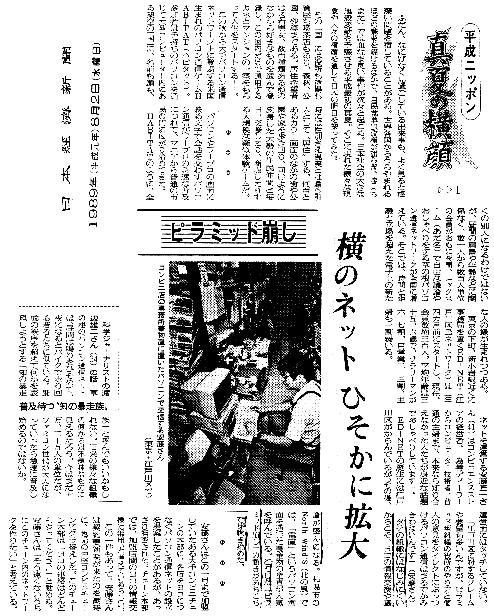 I
have achieved so far a part of my life task with my considerable time, efforts
and private funds in the past two decades -- it was certainly a long, lonely
strenuous road [56], since dealing with Japanese, particularly its
government and monopolistic telecommunication industries (e.g., KDD) was
like peeling the onion, as many American trade negotiators criticized!!
I was, however, fortunate to have the generous support and help from the
U.S. White House, the U.S. Trade Representative (USTR), the U.S. Department
of Commerce (particularly the Late Secretary Malcom Baldrige), the U.S.
Federal Communications Commission, American educational and industrial organizations,
and the Japanese Liberal Democratic Party (especially, Mr. Tadashi Kuranari,
former Minister of Foreign Affairs and one of my family friends), to name
but a few among many in the U.S., Japan and other countries.
I
have achieved so far a part of my life task with my considerable time, efforts
and private funds in the past two decades -- it was certainly a long, lonely
strenuous road [56], since dealing with Japanese, particularly its
government and monopolistic telecommunication industries (e.g., KDD) was
like peeling the onion, as many American trade negotiators criticized!!
I was, however, fortunate to have the generous support and help from the
U.S. White House, the U.S. Trade Representative (USTR), the U.S. Department
of Commerce (particularly the Late Secretary Malcom Baldrige), the U.S.
Federal Communications Commission, American educational and industrial organizations,
and the Japanese Liberal Democratic Party (especially, Mr. Tadashi Kuranari,
former Minister of Foreign Affairs and one of my family friends), to name
but a few among many in the U.S., Japan and other countries.
As the result, the use of e-mail (the so-called PASOCON-TSUSHIN (= personal computer telecommunication) in Japanese) became proliferated in Japan as reforming a hierarchical structure of the Japanese society to horizontal, achieving a goal of my effort (Nikkei Shimbun, August 2, 1989 [57]). I was particularly happy when I saw an article in Nikkei Shimbun a few years ago which the results of a survey reported that almost 50% of Japanese youngsters now do no longer want to have life-long employment system -- see also my acceptance speech of the Lord Perry Award for Excellence in Distance Education.
A Japanese newspaper described that the inauguration of international data telecommunication services (ICAS and VENUS of KDD) was the "Third Opening of Japan," following the second of introducing democracy by General Douglas MacArthur and the first by Commodore Perry's black ship about 150 years ago.
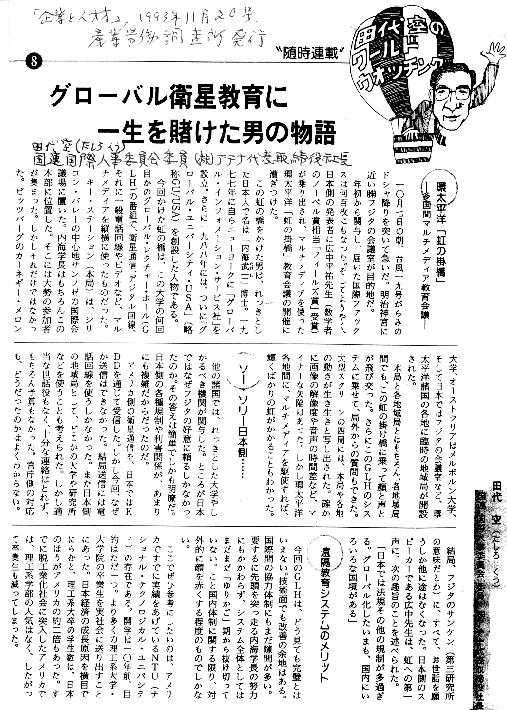 In
view of my effort of introducing the U.S. packet-switching data telecommunication
network to Japan, de-regulation and de-monopolization of the Japanese telecommunication
policies and industries, and their consequential impact to the Japanese
society, Rector Hironaka of Hiroshima University (former dean of mathematics
at Harvard University and Field Award laureate) termed me as a revolutionist
as Ryuma Sakamoto, who initiated Meiji revolution about 130 years ago (Tashiro, Ku, 1993) [58].
In
view of my effort of introducing the U.S. packet-switching data telecommunication
network to Japan, de-regulation and de-monopolization of the Japanese telecommunication
policies and industries, and their consequential impact to the Japanese
society, Rector Hironaka of Hiroshima University (former dean of mathematics
at Harvard University and Field Award laureate) termed me as a revolutionist
as Ryuma Sakamoto, who initiated Meiji revolution about 130 years ago (Tashiro, Ku, 1993) [58].
I was also very happy to learn that 80 million people now use e-mail worldwide (40 million in the U.S.) and 60% of Internet usage for e-mailing. A colleague in Croatia said "GLOSAS project is the Archimedes' lever." [59]
"The GLOSAS Project is Dr. Utsumi's second social revolution!" said a high ranking officer of the Japanese Ministry of International Trade and Industry (MITI) in the summer of 1991, referring to the fact that the deregulation significantly contributed to and continued to exert influences on the change in the Japanese society and industry.
Information and telecommunication are the very basic infrastructure of
economic development, as attested by the rapid rise of Japan to the world
economic power after the de monopolization and liberalization of the telecommunication
policies and industries in early 1980s. This also brought a transformation
and upheaval of the Japanese society from being feudalistic (vertical) to
democratic (horizontal). Yet, that was after her reformation of only hardware-oriented
information infrastructure. Our projects now focus more on substance and
content of the information, i.e., knowledge and education. This was the
reason why the above comment was made by the MITI officer.
[Go to CONTENTS]
Utsumi, T., C. H. Jones and L. Chin, 1970, "Optimization of CSMP/360 or Hybrid Models," 1970 SCSC Proceedings, Pages 143-153.
Utsumi, T. and A. Garzon, 1991, "Global University for Global Peace Gaming," Proceedings of the 22nd International Conference of the International Simulation and Gaming Association (ISAGA), Kyoto, Japan, 15-19 July, 1991, Pages 112 to 120, Springer-Verlag
Utsumi, T. and E. A. Eschbach,
1974, "Joint USA/Japan Project on Global Systems Analysis and Simulation
(GLOSAS) of Energy, Resources and Environmental (ERE) Systems," Proceedings
of 1974 SCSC, Houston, TX, July, 1974, Pages 343-353.
[Go to CONTENTS]
INSERTIONS (Images, graphs and diagrams, etc.):
Asahi Shimbun, March 12, 1979, "Real-time Databank Retrieval from the U.S.," In Japanese (Permission to be obtained later.)
Asahi Shimbun, July 16, 1980, "Inauguration
of KDD's ICAS Service:
Instantaneous Information Retrieval from the U.S.," In Japanese
(Permission to be obtained later.)
Berger, Michael, 1987, "Newsmaker:
Japan's MPT chief seeks less regulation, endorses standards," Data
Communication, January, Page 97 to 98 (Permission to be obtained later.)
Chunichi Shimbun, October 31, 1981, "Remove
Non-Tariff Barrier," In Japanese and English translation (Permission
to be obtained later.)
Computing Europe, February 16, 1978, Reports on a Transnational Data Regulation Conference (Permission to be obtained later.)
Datamation, April 1, 1994, "E-Mail Or E-Female?" Page 21 (Permission to be obtained later.)
Ishida, H., 1991, Private communication
Malik, R., September 8, 1977, "In person:
Packet-switching's unsung hero," New Scientist (Permission to be
obtained later.)
Millennium Institute, "Cause and Effect Diagram of Threshold 21 National Sustainable Development Model," <http://www.igc.org/millennium/t21/index.html#intro> (Permission granted on July 23, 1998, by an e-mail.)
National Science Foundation, "Diagram of
CSNET," 1981
Nikkei Sangyo Shimbun, March 22, 1979, "Networking
Industry: Mountain of Treasures," In Japanese (Permission to be
obtained later.)
Nikkei Shimbun, November 4, 1973, "Japan-U.S. Online Energy Information via Satellite," In Japanese (Permission to be obtained later.)
Nikkei Shimbun, November 27, 1978, "Information Retrieval from the U.S.," In Japanese (Permission to be obtained later.)
Nikkei Shimbun, December 15, 1979, "FCC allowed KDD's ICAS," In Japanese (Permission to be obtained later.)
Nikkei Shimbun, July 31, 1980, "Opening of International Data Telecommunications Services," In Japanese (Permission to be obtained later.)
Nikkei Shimbun, September 5, 1980, "Demonstration of ICAS Services," In Japanese (Permission to be obtained later.)
Nikkei Shimbun, September 12, 1980, "Many ICAS Users: More than Ten Times than Expected," In Japanese (Permission to be obtained later.)
Nikkei Shimbun, December 22, 1980,"Prosperous
Online Services," In Japanese (Permission to be obtained later.)
Nikkei Shimbun, August 2, 1989, "Crumbling
Down Pyramid," In Japanese (Permission to be obtained later.)
Norris, William C., 1983, "Limiting Japan's Access to Our Research," The New York Times, July 24, (Permission to be obtained later.)
Tashiro, Ku, 1993, "Story of the Man who Devoted His Life to Global Distance Education," Kigyo to Jinzai, November 20, 1993, In Japanese (Permission to be obtained later.)
U.S. Dept. of Commerce, 1982, Letter of Notification, April 6.
Utsumi, T., 1970, "A Message from the Program Chairman," Proceedings of the 1970 SCSC, Denver, Colorado
Utsumi, T., 1971a, "A Message from the General Chairman," Proceedings of the 1971 SCSC, Boston, Massachusetts
Utsumi, T., 1971b, "Peace and War Gaming"
Utsumi, T., 1971c, "Comparison between War and Peace Games"
Utsumi, T., 1981, "Extension of CSNET to Japan"